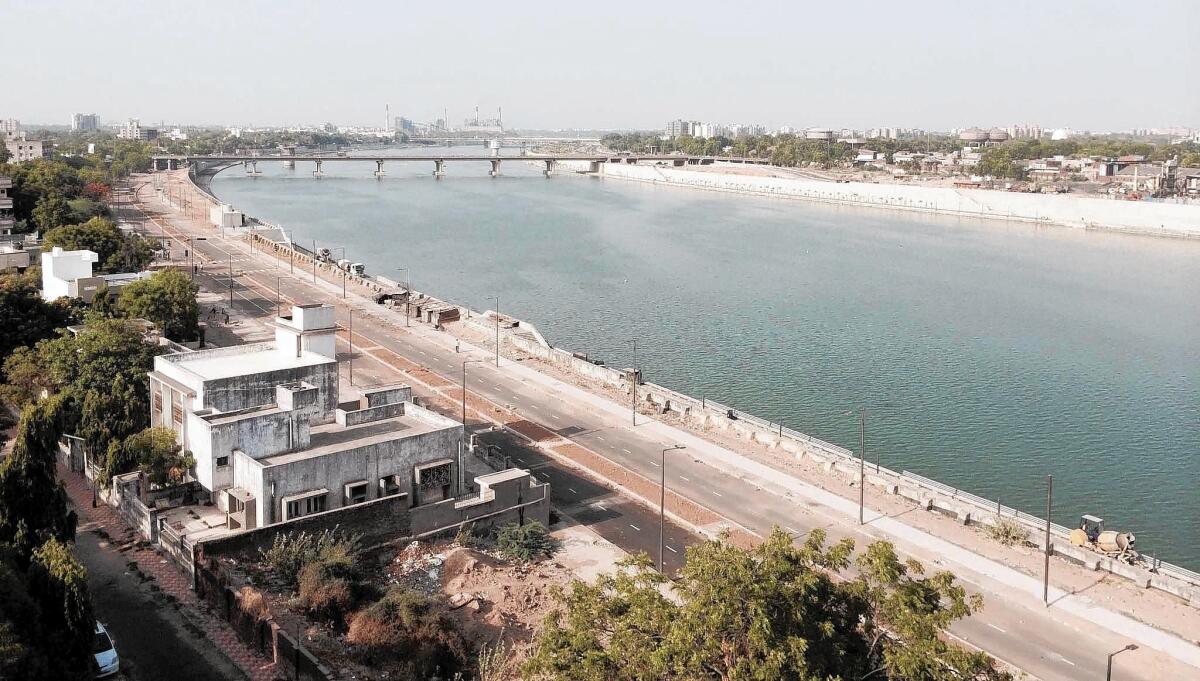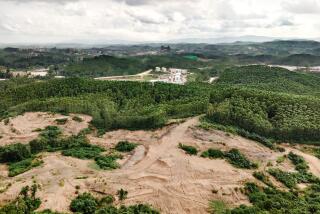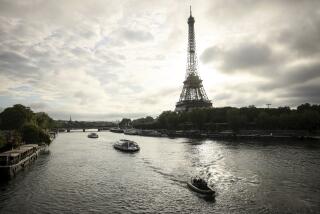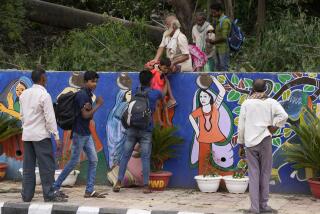India river development project is a double-edged sword

Reporting from Ahmedabad, India — Civic leaders had long looked upon the dreary, slum-choked river that sliced through this city and dreamed it could become something grand — India’s answer to the Seine or the Thames.
When a new chief executive took over the state of Gujarat in 2001, he directed municipal authorities to make the Sabarmati River a priority. Now that official, Narendra Modi, is India’s prime minister, and he has touted the $200-million public project as a symbol of his ability to advance major development ventures that lift India’s economy as well as its poorest citizens.
Yet far from the rejuvenated riverfront, in a sun-baked field in the shadow of a noxious recycling plant, thousands of impoverished slum dwellers whose homes were razed in the redevelopment say they are worse off than before.
With city officials having failed to find them alternative housing as promised, the families are stuck in a temporary housing site, living in tumbledown shacks made of plywood and plastic sheets that fall apart during the heavy summer rains, miles from city services or decent jobs.
“They built a megacity there, and we’re all sitting here,” said Laxmi Devipujak, a mother of two wearing a red sari and brass nose ring, crouched on the mud floor of a neighbor’s hut. “We gave the authorities gold and we got rupu [cheap metal] in return.”
A breakneck economic expansion over the last two decades has remade India’s cities, producing new mass transit systems, shimmering airports and ultra-modern industrial parks. Few urban renewal projects, however, have been as celebrated as the Sabarmati riverfront, which reclaimed a seven-mile stretch of water and its banks in the heart of one of India’s largest cities.
Once a bleak riverbed that was dry most of the year, the Sabarmati that winds through central Ahmedabad is now a swelling and much cleaner waterway, fed by canals and barrages from an upstream river. The shacks and trash heaps at the water’s edge have been replaced by wide concrete promenades studded with street lamps, and large empty tracts where developers hope to build.
Although the riverfront is far from complete, city and state authorities have flaunted its rehabilitation all over India, winning numerous government awards and recognition from the international consulting firm KPMG. In his barnstorming campaign for prime minister this year, Modi made the river a byword for responsible development.
“Those who are singing the tune of ‘inclusive growth, inclusive growth,’ I ask them to visit Sabarmati riverfront,” Modi said at one campaign stop.
But experts say that underneath Modi’s aggressive boosterism lie familiar shortcomings. They contend that the growth has prioritized a prominent middle class — the symbol of a rising India, those who can afford plane tickets and riverboat rides — while neglecting poor families displaced by new construction.
The policies have contributed to a widening wealth gap in India, which ranks among the most inequitable societies in the world. Although the overall economy has more than doubled in size in the last decade, one-third of the population — about 400 million people — still lives on less than $1.25 a day, according to World Bank figures.
Overhauling the Sabarmati required one of the largest urban resettlement programs undertaken in India. Tens of thousands of poor riverfront families were given space in government-built apartment blocks, but most were located on the outer reaches of the city, all but disconnected from transit networks, utilities and people’s former livelihoods, the families said.
Some of the buildings were unfinished or lacked potable water, problems that took city authorities years to resolve. Hundreds of families never secured apartments because they were missing paperwork, activists said, forcing many into temporary camps where they have languished.
“There’s been a very successful narrative about how this is inclusive development,” said Renu Desai, a professor of urban planning at CEPT University in Ahmedabad. “Whereas what you really see is not different from other cities in India. It’s the marketing that stands out.”
More than 1,000 uprooted families still live in tents in a remote temporary housing site at Ganeshnagar, 10 miles from central Ahmedabad, boxed in by a recycling plant, electrical transmission towers and the city’s largest trash dump. Most arrived in late 2011, during the last phase of slum evictions from the Sabarmati riverside, with city authorities promising to move them to apartments within two months.
Many no longer believe they will ever see those homes. Before, living along the river in the hub of the city, the women sold vegetables, washed clothes, or labored as housekeepers for nearby middle-class families. Now many say they are jobless, their husbands forced to travel by costly rickshaws back to the city center to search for menial work.
Often the families go to bed hungry. The next morning they begin the daily struggle again, lining up before dawn to bathe in an overflowing communal bathroom, taking care not to step on snakes.
“We’ve lost our way of life,” Devipujak said, swatting at flies as a group of women murmured in agreement.
Some have lost even more. In April, a rainstorm caused a spark in one of the nearby electrical towers that spread to a hastily buried cable under Ganeshnagar. The cable caught fire, shocking two teenagers playing in a field.
Fifteen-year-old Mahesh died of his injuries, said his mother, Bhuri Bharia, wearing a yellow sari and a tired expression. The boy’s shredded clothes still lay in a heap in the field.
“If the city would put us in real homes as we were promised, this would never have happened,” said another woman, Asha Dantani, a mother of four.
Backers of the Sabarmati project boast that it has restored a major waterway by diverting another river upstream with a series of canals and barrages and made the riverfront a center of civic life just as it was a century ago, when Mohandas Gandhi established an ashram on the western bank.
Two years ago, to mark the launch of riverboat rides, Modi boarded a speedboat and waved to a crowd gathered along one of the new promenades. There are plans for an amusement park, sports facilities and a floating restaurant owned by a Bollywood actor.
The proponents dismiss the complaints of activists, saying the old river was clogged with sewage and the tin-roofed shanties clustered along the banks blocked access for the general public. HCP, an Ahmedabad firm that helped design the project, said the redevelopment would “restore the city’s relationship with the river.”
“The activists are the problem,” thundered Surendra Patel, a prominent member of Modi’s Bharatiya Janata Party and former chairman of the Ahmedabad Urban Development Authority. “They want to keep people in the slums. They’re not interested at all in lifting people up.”
But experts say the development is a prime example of public funds benefiting middle-class Indians at the expense of the country’s poorest. For the former slum dwellers, the roads, boat rides and even a new regulated Sunday bazaar all seem out of reach.
“Yes, it is development,” said Beena Jadhav, a social worker who was active in the resettlement effort. “But you have to ask yourself: Development for whom?”
More to Read
Sign up for Essential California
The most important California stories and recommendations in your inbox every morning.
You may occasionally receive promotional content from the Los Angeles Times.











